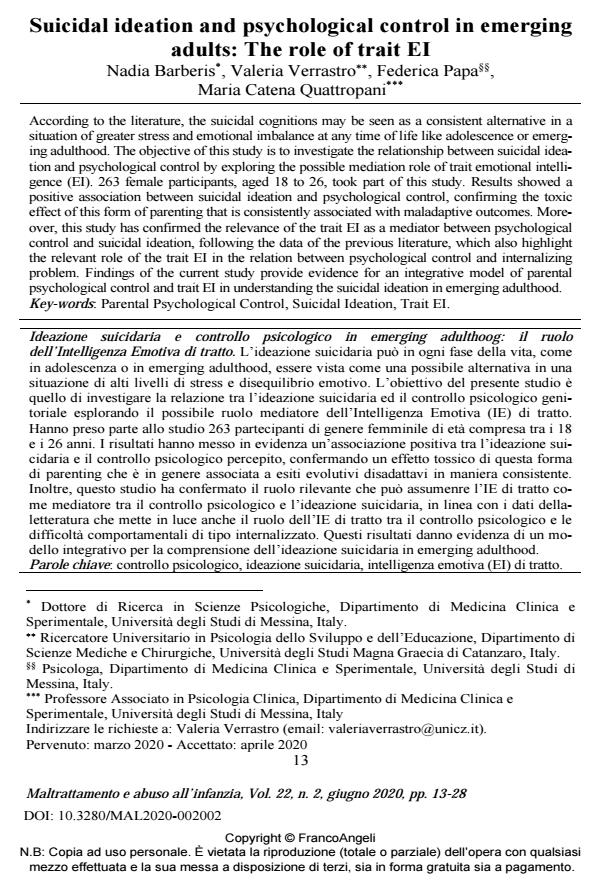Suicidal ideation and psychological control in emerging adults: The role of trait EI
Journal title MALTRATTAMENTO E ABUSO ALL’INFANZIA
Author/s Nadia Barberis, Valeria Verrastro, Federica Papa, Maria Catena Quattropani
Publishing Year 2020 Issue 2020/2
Language English Pages 16 P. 13-28 File size 240 KB
DOI 10.3280/MAL2020-002002
DOI is like a bar code for intellectual property: to have more infomation
click here
Below, you can see the article first page
If you want to buy this article in PDF format, you can do it, following the instructions to buy download credits

FrancoAngeli is member of Publishers International Linking Association, Inc (PILA), a not-for-profit association which run the CrossRef service enabling links to and from online scholarly content.
According to the literature, the suicidal cognitions may be seen as a consistent alternative in a situation of greater stress and emotional imbalance at any time of life like adolescence or emerging adulthood. The objective of this study is to investigate the relationship between sui-cidal ideation and psychological control by exploring the possible mediation role of trait emo-tional intelligence (EI). 263 female participants, aged 18 to 26, took part of this study. Results showed a positive association between suicidal ideation and psychological control, confirm-ing the toxic effect of this form of parenting that is consistently associated with maladaptive outcomes. Moreover, this study has confirmed the relevance of the trait EI as a mediator be-tween psychological control and suicidal ideation, following the data of the previous litera-ture, which also highlight the relevant role of the trait EI in the relation between psychological control and internalizing problem. Findings of the current study provide evidence for an inte-grative model of parental psychological control and trait EI in understanding the suicidal idea-tion in emerging adulthood.
Keywords: Parental Psychological Control, Suicidal Ideation, Trait EI.
- Alexithymia in a Self Determination Theory Framework: The interplay of Psychological Basic Needs, Parental Autonomy Support and Psychological Control Nadia Barberis, Marco Cannavò, Francesca Cuzzocrea, Valeria Verrastro, in Journal of Child and Family Studies /2023 pp.2652
DOI: 10.1007/s10826-022-02303-3 - Psychological distress and suicidal ideation in Sicilian Medical Students: The SMS-ME project Nicole Bonaccorso, Giada Tripoli, Ilaria Vella, Caterina La Cascia, Emanuele Amodio, Eleonora Bongiorno, Dario Genovese, Giuseppe Maniaci, Martina Sciortino, Elisa Galatà, Giorgia Iacono, Alessandra Romano, Damiano Guglielmino, Fabio Seminerio, Crocettarachele Sartorio, Alessandra Scaglione, Maria Catena Silvestri, Rosa Lo Baido, Maria Catena Quattropani, Maria Rosaria Anna Muscatello, Carmela Mento, Maria Salvina Signorelli, Diego Quattrone, Francesco Vitale, Daniele La Barbera, Claudio Costantino, Laura Ferraro, in Journal of Affective Disorders Reports 100834/2024 pp.100834
DOI: 10.1016/j.jadr.2024.100834 - Examining the moderating role of academic pressure in the indirect influence of parental psychological control on mental health problems through self-compassion Fangsong Liu, Jiajie Wang, Yabing Wang, in Current Psychology /2025 pp.10403
DOI: 10.1007/s12144-025-07892-y
Nadia Barberis, Valeria Verrastro, Federica Papa, Maria Catena Quattropani, Suicidal ideation and psychological control in emerging adults: The role of trait EI in "MALTRATTAMENTO E ABUSO ALL’INFANZIA" 2/2020, pp 13-28, DOI: 10.3280/MAL2020-002002